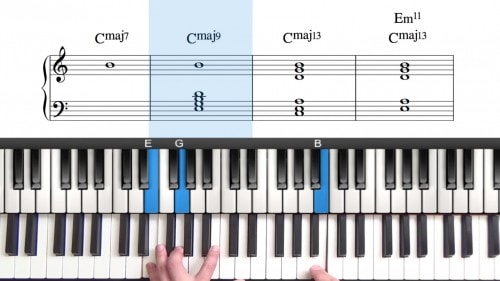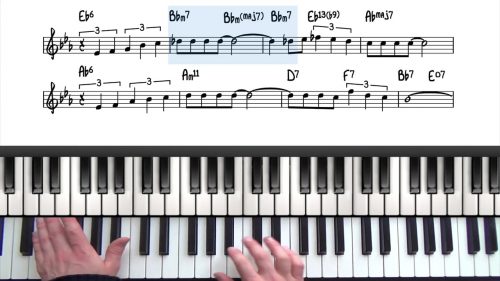What Are You Doing The Rest Of Your Life Part 1
Michel Legrand’s ‘What are you doing the rest of your life’ is a delightful jazz ballad written in the key of C major. This is a challenging tune to learn and contains some difficult to navigate chord changes – particularly in the bridge.
In this lesson we start by playing the melody with left hand voicings to get a good idea of the movement of the chords and the melody. We then add some bigger sounding voicings and more interesting root movements to add interest and dynamics to the arrangement.
We also cover some other interesting voicings options such as sus chords resolving to altered dominant chords . This delays the sense of resolution creates movement and interest when the harmony and melody is stationary.
Practice Tips
The Bill Evans recordings of this tune are definitely worth checking out. He plays the tune with such depth and maturity and there is a lot of emotion in his arrangement.







Hi Hayden, i would be VERY interested in a harmony notation in roman numerals for What Are You Doing the Rest of Your Life. This piece of music is what originally got me interested in jazz piano years ago and it is very difficult which is why i’m curious how to make it easier to memorize. Knowing the roman numeral notation might help with that. This song is absolutely beautifully taught. Thanks for all you do!
Hey Lonnie, sure thing, I am actually almost done notating that one… i’ll have it done for the next lesson i send out. I also love this tune… it’s always been a favourite of mine. Check out these Bill Evans versions… i love the way he plays it:
This is from his album “From Left To Right” where he is playing a Steinway and a Fender Rhodes at the same time:
– it has a nice ballad feel.
This is with his trio and starts off as a very emotive ballad. They then inject an enormous amount of swing into the tune on the second time through (~2:38)…
It’s a hard tune to memorise so stick with it. I’ll get the transcription done for you asap.
Cheers,
Hayden
ps. I haven’t forgot about the A/B Loop video we spoke about… I have found an alternate way to display the A/B loop which will slightly change how it looks and also make it more accurate… it’s a little clunky at the minute!
Hi Hayden, I notice that you are using a mixture of chord inversions and rootless voicings in the left hand. Is this based on the most effective voice leading, or the sound of each inversion or a combination of these ?
My other question is : should a chord inversion have the melody note on top, so it doubles the right hand or not ?
many thanks
Natasha
Hi Natasha 👋🏻
Hope you’re well.
Good questions!
In this tutorial and the subsequent parts (part 2 and 3), we explore a wide range of voicings techniques.
In this lesson – Part 1 – we predominantly explore rootless voicings, and some root position chords. In part 2 we introduce more rooted voicings, sus chords, and passing chords, and then in part 3 we explore bigger 2 handed voicings and the minor line cliche where we move voices at the bottom or within the chord.
For your first question, no matter what type of voicing we use; rooted, rootless, inversions, we can always play good voice leading. The key difference between the different types of voicings is the texture and colour they create.
My idea was to demonstrate the different ways we can play the harmony and then once we have an understanding of the different concepts we can apply them all together to create a full arrangement.
When I play solo piano I like to use a lot of different voicings to create a variety of textures throughout the performance. The A section of this tune repeats 3 times and so when we know a variety of different voicing techniques we can be more creative with our arrangements.
For your second question: no we don’t need to have the melody note on top of the inversion. The melody note is usually played in our right hand, and so we can choose any inversion in the left hand and this will just alter the sound of the chord slightly. Some inversions can sound denser than others depending on how the notes are spaced out.
There is a style of voicing called block chords where we double the melody at the top and bottom of the chord, but we don’t apply that style of playing in the tutorials on this tune. We have a full course on block chords which you may find interesting here: pianogroove.com/jazz-piano-lessons/block-chords-drop-2-voicings/
I hope this helps Natasha and if you have any further questions just let me know.
Cheers,
Hayden